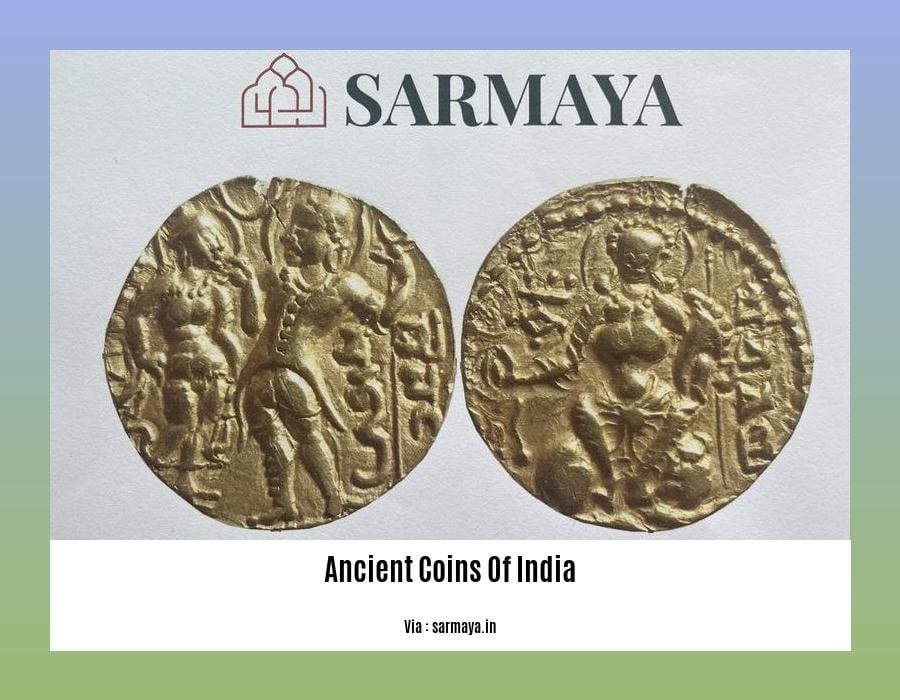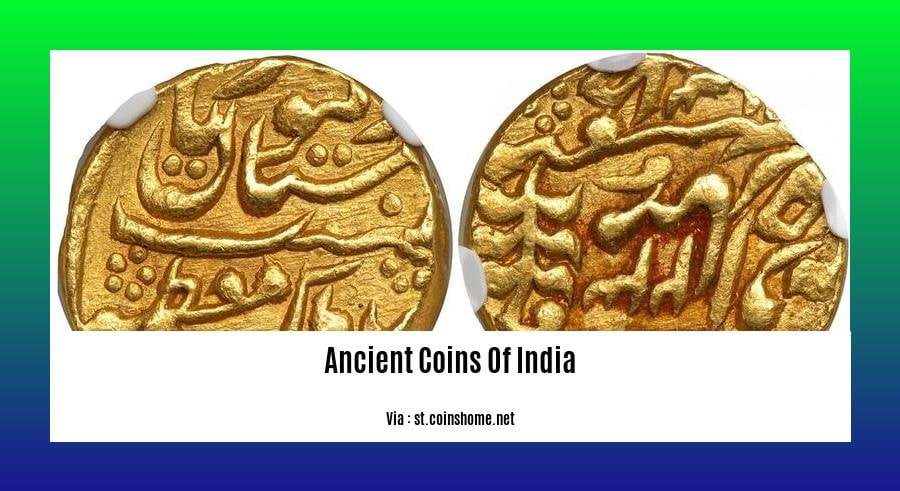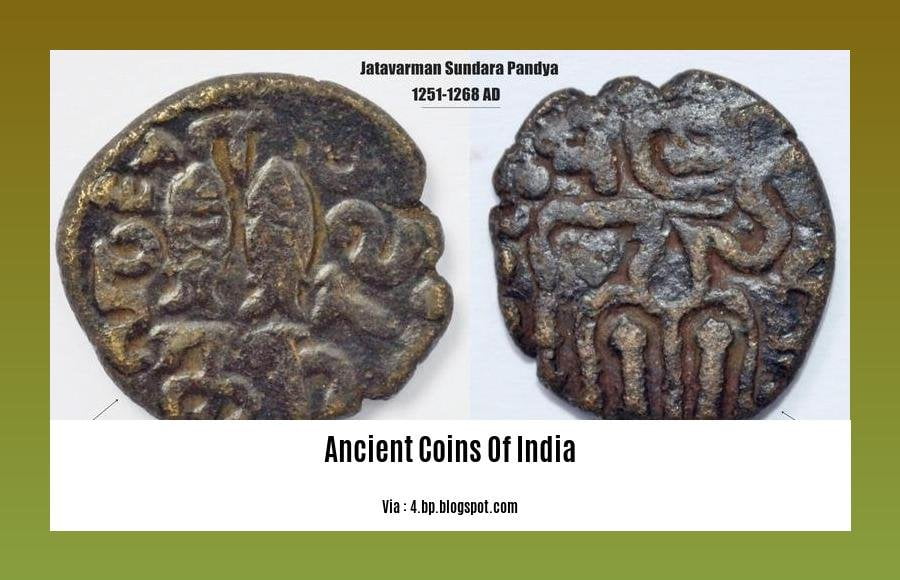Delve into the captivating world of ancient Indian coins and uncover the profound stories they bear in [Exploring the Ancient Coins of India: Unraveling the Stories of India’s Past]. These relics, spanning centuries and diverse kingdoms, offer a tangible link to India’s rich historical tapestry. Each coin, meticulously crafted and adorned with intricate designs and inscriptions, provides a glimpse into the lives, beliefs, and artistic expressions of ancient India. Embark on a journey through time as we decipher the symbolism and inscriptions, revealing the tales of rulers, empires, and cultural influences that shaped India’s past.
Key Takeaways:
Ancient coins of India tell tales of diverse kingdoms, rulers, and cultural influences of the region’s past.
The first coins emerged in India during the 6th century BCE, featuring various symbols and designs by Mahajanapadas.
The Mughal Empire introduced a uniform currency system centered around the silver rupee, gaining popularity and influence.
The British East India Company’s coins displayed monarch portraits and Indian symbols, while post-independence coins depicted national symbols like the Ashoka lion and lotus flower.
Today, collectors and enthusiasts actively seek out rare and valuable Indian coins online and in specialized shops and auctions.
For further exploration, refer to reputable websites like Numista and Wikipedia, offering detailed information on Indian coinage, historical context, and images.
Ancient Coins of India: Unraveling the Stories of India’s Past

Unveiling the Rich Tapestry of Ancient India Through Its Coins
The ancient coins of India are captivating relics that provide glimpses into the diverse kingdoms, rulers, cultural influences, and economic activities that shaped the subcontinent’s history. These intricate pieces of metal hold stories waiting to be deciphered, narrating tales of empires won and lost, trade routes that crisscrossed the land, and the beliefs and symbols that held ancient Indian society together.
A Journey Through Time
The history of ancient coins of India can be traced back to the 6th century BCE, with the emergence of punch-marked silver coins issued by the Mahajanapadas. These early coins featured various symbols, from simple geometric shapes to intricate motifs representing animals and deities. As empires rose and fell, so did the designs and inscriptions on coins, reflecting the changing political landscape and cultural influences.
Deciphering the Symbols and Inscriptions
The ancient coins of India are adorned with a wealth of symbols and inscriptions that hold profound significance. These symbols, ranging from animals and plants to abstract geometric patterns, often carried religious, political, or economic meanings. Inscriptions, often in ancient scripts like Brahmi and Kharoshthi, provide valuable insights into the names of rulers, dynasties, and the dates of coin issuance.
Types of Ancient Indian Coins
The ancient coins of India encompass a wide variety of types, each with its own unique characteristics and historical context. Some of the most notable types include:
- Punch-marked coins: These were the earliest coins issued in India, featuring simple symbols and designs.
- Cast coins: These coins were produced by pouring molten metal into molds, often depicting rulers or deities.
- Die-struck coins: These coins were minted using dies, resulting in more intricate designs and sharper details.
- Gold coins: Gold coins were issued by various kingdoms and empires throughout Indian history, often as a symbol of wealth and power.
Collecting Ancient Indian Coins
Collecting ancient coins of India has become a popular hobby among numismatists and history enthusiasts. These coins offer a tangible connection to India’s rich past, allowing collectors to delve into the lives and stories of ancient rulers, kingdoms, and civilizations. However, collecting ancient coins requires knowledge, caution, and a discerning eye to avoid counterfeits.
Preserving the Legacy of Ancient Indian Coins
The ancient coins of India are a valuable part of the nation’s cultural heritage, and it is essential to preserve them for future generations. Proper storage and handling techniques, along with responsible collecting practices, help ensure these coins remain intact and accessible for study and appreciation.
Conclusion
The ancient coins of India are windows into the fascinating history of the Indian subcontinent. They hold stories of power, wealth, trade, and cultural exchange, waiting to be discovered and interpreted. By studying and appreciating these coins, we gain a deeper understanding of India’s past and the enduring legacy it has left on the world.
Discover the hierarchy and structure of ancient chinese military ranks throughout history by clicking here.
Delve into the fascinating world of ancient coins of india price and explore their historical significance and current market value.
Embark on a journey through time as you uncover the ingenious and diverse ancient fishing methods employed by our ancestors.
Designs, Symbols, and Motifs on Ancient Indian Coins: Unveiling the Stories of India’s Past
Imagine traveling back in time, holding an ancient Indian coin in your hand. Each coin tells a story of India’s glorious past, revealing the artistry, beliefs, and power struggles of bygone eras. The designs, symbols, and motifs on these coins offer a captivating glimpse into the hearts and minds of our ancestors. Join us on a journey to explore the intricate world of ancient Indian coins.
Motifs: A Tapestry of Cultural Influences
Ancient Indian coins are adorned with a rich tapestry of motifs, mirroring the cultural diversity of the subcontinent. From the majestic lion of the Mauryan Empire to the mythical bird Garuda of the Gupta Empire, these motifs reflect the religious, political, and cultural influences that shaped India’s history. Each design tells a story, connecting us to the beliefs and aspirations of ancient Indians.
Symbols: Power and Legitimacy
Symbols on ancient coins convey messages of authority and legitimacy. Rulers often depicted themselves as divine figures or powerful animals, reinforcing their claim to power. Symbols like the chakra (wheel) or the swastika (sun symbol) carry deep religious and cultural significance, representing the cosmos, prosperity, and good fortune. These symbols served as visual affirmations of a ruler’s authority and the stability of their kingdom.
Inscriptions: A Window to the Past
Inscriptions on ancient coins provide invaluable insights into the lives and times of our ancestors. They reveal the names, titles, and genealogical lineages of rulers, shedding light on political alliances, conquests, and successions. Inscriptions also mention mint locations, coin denominations, and religious texts, offering glimpses into the economic and cultural landscape of ancient India.
Key Takeaways:
- Ancient Indian coins are adorned with a rich array of designs, symbols, and motifs, reflecting the cultural diversity and historical influences of the subcontinent.
- Motifs on coins depict religious figures, mythical creatures, and symbols of power, providing insights into the beliefs and aspirations of ancient Indians.
- Symbols convey messages of authority and legitimacy, reinforcing rulers’ claims to power and the stability of their kingdoms.
- Inscriptions on coins reveal the names, titles, and lineages of rulers, mint locations, coin denominations, and religious texts, offering valuable historical and economic information.
Sources:
– भारतीय पुरातत्व सर्वेक्षण: https://asi.nic.in/
– भारतीय रिजर्व बैंक:
Cultural and Historical Significance of Ancient Indian Coins

Imagine yourself transported back in time, holding an ancient Indian coin in your hand. What tales would it tell? What insights could it offer about India’s rich past? Journey with me as we delve into the captivating world of ancient Indian coins, unearthing their cultural and historical significance.
Key Takeaways:
- Ancient Indian coins are valuable artifacts providing glimpses into India’s glorious past and its diverse kingdoms, rulers, and cultural influences.
- Studying these coins helps historians piece together political, economic, and social aspects of ancient India and its intricate trade routes.
- Various types of ancient Indian coins, including punch-marked, cast, die-struck, and gold coins, showcase the evolution of coinage and monetary systems.
- The intricate designs, symbols, and inscriptions on ancient Indian coins offer insights into religious beliefs, artistic expressions, and cultural practices of ancient India.
- Collecting and preserving ancient Indian coins responsibly contributes to preserving India’s rich cultural heritage for future generations.
The Coin’s Perspective
Picture an ancient gold coin, adorned with the effigy of a mighty king. It whispers tales of battles won, territories conquered, and alliances forged. Its weight and purity speak volumes about the economic stability and prosperity of the kingdom it once served.
A Window to Religious Beliefs
Hold in your hand a silver coin adorned with the image of a deity. Its intricate carvings hint at the reverence and devotion of ancient Indians towards their gods and goddesses. Through these coins, we glimpse the spiritual tapestry of ancient India, where religion and governance were intertwined.
Trade and Economic Activities
Ancient coins served as more than just mediums of exchange. They were symbols of trust and a testament to the thriving trade networks that connected India with far-flung lands. Marks and symbols on these coins hint at trade routes, guilds, and taxation systems, providing insights into the economic vitality of ancient India.
Preserving the Legacy
The legacy of ancient Indian coins extends beyond their historical and cultural significance. As passionate collectors and guardians of history, we hold a responsibility to preserve these coins for future generations. Proper storage, careful handling, and ethical collecting practices ensure that these precious artifacts remain intact, allowing us to continue learning from and appreciating their enduring value.
[Source 1: Reserve Bank of India:
[Source 2: Britannica:
Collecting and Preserving Ancient Indian Coins: A Guide for Enthusiasts
In the vast tapestry of Indian history, ancient coins serve as windows into a bygone era, whispering tales of forgotten rulers, empires, and cultural influences. As a collector, venturing into the realm of ancient Indian coins can be a captivating journey filled with excitement and discovery. However, before embarking on this numismatic adventure, let’s delve into the world of ancient Indian coinage and unearth the secrets of collecting and preserving these precious artifacts.
Key Takeaways:
- Ancient Indian coins offer a tangible connection to India’s rich history and cultural heritage.
- Collecting ancient Indian coins requires patience, knowledge, and a keen eye for authenticity.
- Proper storage and handling techniques are crucial to preserving the integrity and value of these artifacts.
- Consulting reliable sources, attending numismatic events, and joining collector communities can enhance your understanding and appreciation of ancient Indian coins.
A Journey Through Time: The Allure of Ancient Indian Coins
The journey of ancient Indian coinage spans over two millennia, beginning with the punch-marked coins of the 6th century BCE and continuing till the 12th century CE. These coins, crafted from metals like gold, silver, copper, and bronze, bear witness to the rise and fall of empires, the evolution of artistic styles, and the interplay of religious and political influences.
Collecting Ancient Indian Coins: A Passionate Pursuit
1. Building Knowledge: Laying the Foundation
– Acquire knowledge about ancient Indian history, numismatic terminology, and coin identification techniques.
– Familiarize yourself with different coin types, their historical context, and distinguishing features.
2. Authenticity: The Cornerstone of Collecting
– Seek coins with clear inscriptions, recognizable symbols, and consistent designs.
– Beware of replicas, forgeries, and altered coins; consult reputable dealers and experts for guidance.
3. Responsible Acquisition: Ethical Considerations
– Support ethical and legal acquisition channels to ensure the preservation of our cultural heritage.
– Avoid acquiring coins of questionable origin or those obtained through illicit means.
Preserving Ancient Indian Coins: A Legacy to Cherish
1. Proper Storage: A Safe Haven for Your Collection
– Store coins in airtight containers or coin holders to protect them from moisture, dust, and tarnishing.
– Choose a stable storage environment with controlled temperature and humidity levels.
2. Careful Handling: A Touch of Reverence
– Handle coins with clean hands or numismatic gloves to prevent damage to their surfaces.
– Avoid exposing coins to harsh chemicals, abrasive surfaces, or direct sunlight.
3. Conservation and Restoration: Preserving the Past
– Seek professional conservation services for coins that require specialized care or restoration.
– Cleaning coins should be done cautiously and only by experienced numismatists to avoid damaging their surfaces.
Expanding Your Numismatic Horizons
1. Numismatic Resources: A World of Knowledge
– Consult numismatic books, journals, and online resources to deepen your understanding of ancient Indian coins.
– Attend numismatic conferences, exhibitions, and coin shows to learn from experts and fellow collectors.
2. Collector Communities: A Network of Enthusiasts
– Join local or online numismatic societies to connect with like-minded collectors.
– Participate in coin forums, discussions, and online communities to share knowledge and experiences.
Conclusion: A Legacy in Your Hands
Collecting and preserving ancient Indian coins is a noble pursuit that connects us to our rich history and cultural heritage. As custodians of these precious artifacts, we have a responsibility to handle them with care, preserve their legacy, and pass on the stories they hold to future generations. Let’s embrace this numismatic journey with passion, knowledge, and a deep appreciation for the timeless beauty of ancient Indian coins.
Sources:
- Reserve Bank of India: Ancient Indian Coins
- The Numismatic Society of India
FAQ
Q1: What are punch-marked coins, and when were they used in India?
A1: Punch-marked coins were the earliest form of coinage in India, dating back to the 6th century BCE. They were made of silver and adorned with various symbols, marks, and inscriptions, indicating their origin and value.
Q2: How did Greek and Roman coins influence ancient Indian coinage?
A2: During the Hellenistic period, Greek and Roman coins influenced Indian coinage through trade routes. Greek coins like the drachma and tetradrachm were imitated, leading to new coin types. Roman coins, such as the aureus and denarius, also influenced Indian coinage, particularly in design and motifs.
Q3: What were some of the significant coins issued during the Gupta and Kushan Empires?
A3: The Gupta Empire introduced remarkable gold coins, intricate in design and high in purity. These coins often featured images of gods and goddesses, along with rulers and their titles. The Kushan Empire also issued gold and silver coins with Greek and Indian motifs, reflecting their cultural diversity.
Q4: What insights do ancient Indian coins provide into the religious beliefs and cultural practices of ancient India?
A4: Ancient Indian coins often depicted religious symbols, deities, and inscriptions related to religious beliefs. By studying these coins, historians gain insights into the religious practices, rituals, and beliefs prevalent during different periods in ancient India.
Q5: What are some of the challenges faced in studying and interpreting ancient Indian coins?
A5: Studying ancient Indian coins can be challenging due to their age, rarity, and the limited historical documentation available. Interpreting the symbols, marks, and inscriptions on these coins requires expertise in numismatics, archaeology, and ancient Indian history. Additionally, the condition and preservation of the coins can also impact their interpretability.
- Sept 31 Myth: Unveiling Calendar Secrets - March 18, 2025
- How Long & Till December 18, 2025: Accurate Countdown Guide - March 18, 2025
- Discover Japanese Artists: A Complete History - March 18, 2025

![[Ancient Coins of India Price]: Unveiling the Value of Historical Treasures ancient-coins-of-india-price_2](https://www.lolaapp.com/wp-content/uploads/2023/12/ancient-coins-of-india-price_2-150x150.jpg)














